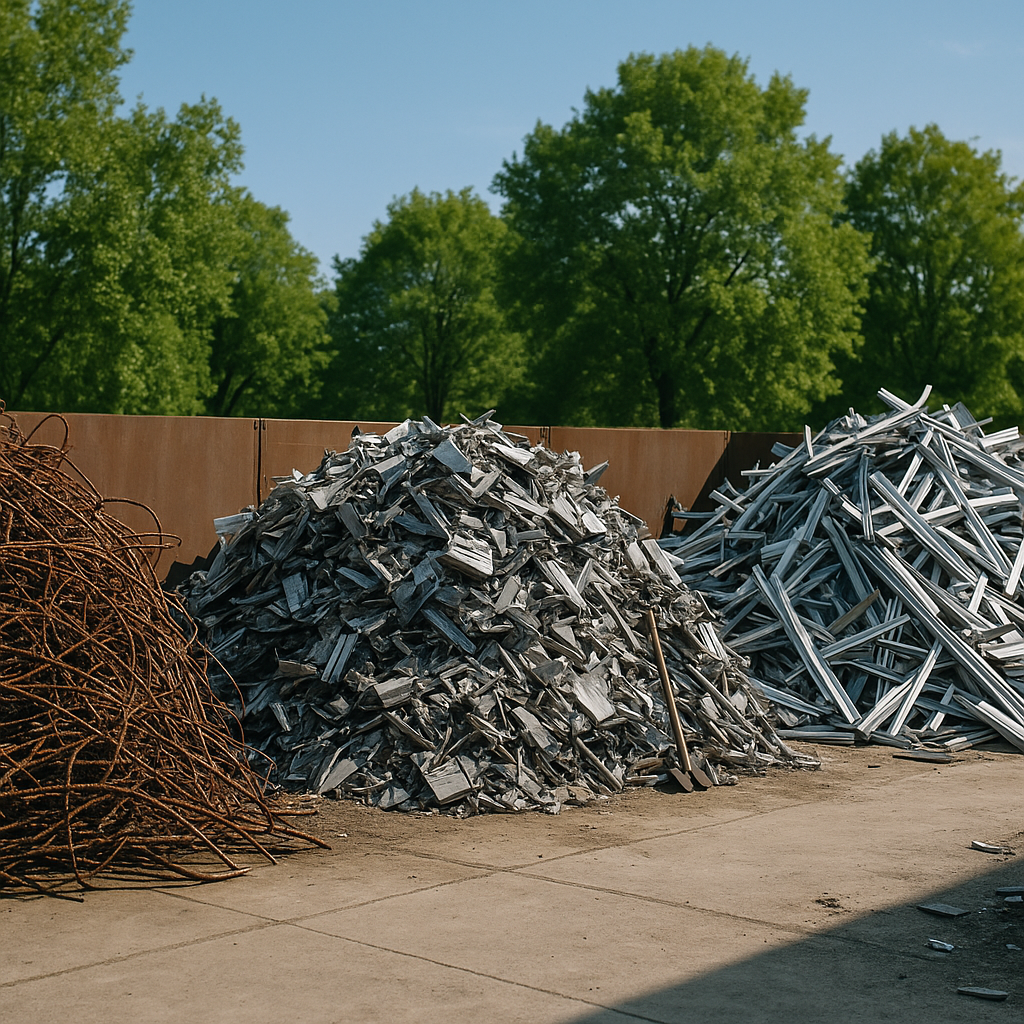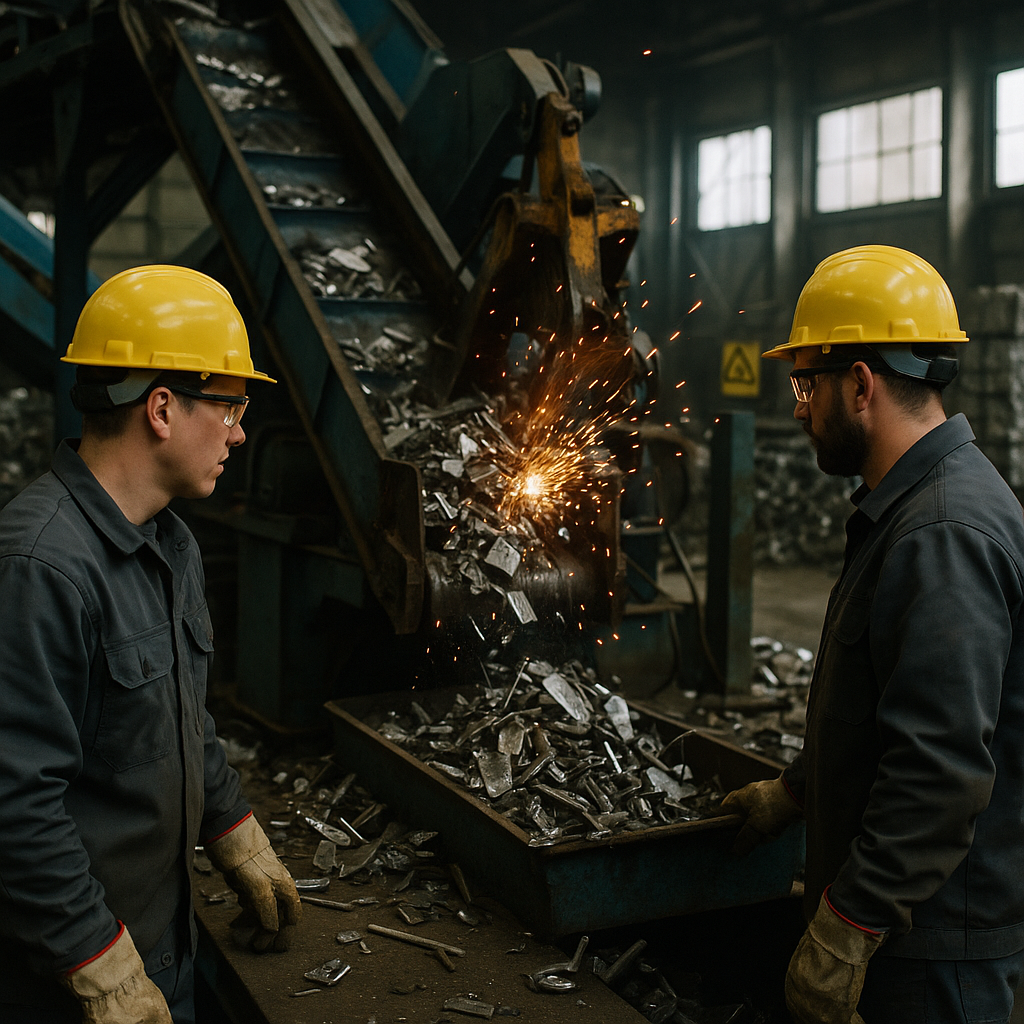5901 Botham Jean Blvd, Dallas, TX 75215
Ferrous Scrap Recycling: Environmental Benefits, Economic Impact, and Circular Economy Solutions
September 5, 2025Ferrous scrap recycling involves recovering and reprocessing metals containing iron. Whenever a magnet sticks to metal, you’ve identified ferrous material that can be recycled. This includes steel beams from construction sites, old vehicles, railroad tracks, and common household appliances like refrigerators and washing machines.
The steel industry heavily relies on ferrous scrap recycling. Steel is the most recycled material in the world, with nearly 98% of structural steel being recovered and processed for reuse. This marks ferrous recycling as one of the most significant examples of sustainable resource management in the modern industrial economy.
Though often unnoticed, ferrous metals are prevalent in our daily lives. The structural framework of buildings, car bodies, shipping containers, and farm equipment all contain ferrous metals that can be collected, sorted, processed, and transformed into new products without losing their inherent strength or quality. This remarkable characteristic allows ferrous metals to be recycled repeatedly in a genuine circular process.
What are the Environmental Benefits of Ferrous Scrap Recycling?

Recycling ferrous scrap metals offers significant environmental benefits that go beyond simple waste reduction. By recycling steel and iron materials, the demand for virgin ore mining decreases. This preservation of natural landscapes prevents habitat destruction, soil erosion, and water contamination usually caused by mining operations.
The energy savings from ferrous recycling are significant. The process requires much less energy than extracting and refining raw materials. In fact, recycled steel production uses up to 74% less energy compared to making steel from virgin materials, resulting in lower fuel consumption and reduced strain on energy resources.
A particularly compelling benefit is the notable reduction in greenhouse gas emissions. Utilizing recycled ferrous scrap lowers CO2 emissions by 58% compared to virgin material production, which helps combat climate change by reducing the carbon footprint of metal manufacturing. For every ton of steel recycled, approximately 1.5 tons of iron ore, 0.65 tons of coal, and 0.3 tons of limestone are saved.
Another critical environmental advantage is water conservation, as the recycling process requires 40% less water than traditional steel production methods. Protecting water resources is increasingly vital as many areas face growing water scarcity challenges.
Ferrous scrap recycling is also crucial in waste management by diverting materials from landfills. Steel decomposes extremely slowly, occupying valuable landfill space and potentially leaching contaminants into soil and groundwater. By recycling these materials, we extend the life of existing resources while reducing waste accumulation.
The cumulative impact of these benefits creates a strong environmental case for ferrous recycling. Each ton of recycled metal signifies tangible resource savings and pollution prevention. Steel’s infinite recyclability means it can be reprocessed repeatedly without degrading its quality, making it an ideal material for circular economy initiatives.
Beyond direct environmental benefits, ferrous recycling supports broader sustainability goals across industries. Construction projects using recycled steel contribute to green building certifications. Manufacturing companies can reduce their carbon footprint by incorporating recycled materials. Even automotive production benefits from the reduced environmental impact of recycled steel components.
The environmental advantages of ferrous scrap recycling provide a compelling case for prioritizing recycled materials whenever possible. By directing these valuable resources from waste streams back into production, we conserve natural resources, reduce emissions, and support sustainable industrial practices.
How is Ferrous Scrap Processed and Recycled?

The ferrous scrap recycling process transforms discarded iron-containing metals into valuable resources through a series of specialized steps. This systematic approach ensures steel can be continuously recycled without losing quality, making it one of the most recycled materials worldwide.
The journey begins with collection from various sources. Ferrous scrap primarily comes from home scrap generated within steel mills, prompt or industrial scrap from manufacturing operations, and obsolete scrap from end-of-life products and structures. These materials flow from demolition sites, manufacturing facilities, junkyards, and even household waste.
Sorting is the next critical phase where ferrous metals are separated from non-ferrous materials, primarily using magnetic technology. Since ferrous metals contain iron, they respond to magnetic forces, allowing recyclers to use powerful magnets to efficiently pull them from mixed waste streams. Advanced recycling facilities employ sophisticated sorting technologies including magnetic separators, eddy current systems, and optical sorters to ensure proper classification.
After sorting, the scrap undergoes preparation and size reduction. Large pieces are cut into manageable sizes using hydraulic shears, while smaller materials enter industrial shredders that break them down into dense, uniform fragments. This shredding process increases surface area and density, enhancing melting efficiency in subsequent stages.
The processed scrap then enters the melting phase. Steel mills place the prepared material into furnaces reaching temperatures approaching 3,000 degrees Fahrenheit. Electric arc furnaces (EAFs) are commonly used for scrap recycling as they offer precise temperature control and use significantly less energy than steel production from raw ore. During melting, impurities are removed to ensure the final metal meets quality standards.
After melting, the purified liquid steel undergoes solidification and forming. The molten metal is poured into molds or cast into specific shapes like sheets, bars, or ingots according to manufacturer requirements. These intermediate forms are then ready for shipment to various industries where they’ll be transformed into new products.
The final phase is manufacturing, where the recycled ferrous material becomes new consumer and industrial goods. The recycled steel retains its structural integrity and performance characteristics, making it suitable for applications ranging from construction materials and automotive components to appliances and packaging. The cycle can then repeat indefinitely, as steel products reaching the end of their useful life become tomorrow’s recycled materials.
What are the Economic Impacts of Ferrous Scrap Recycling?

The ferrous scrap recycling industry serves as a powerful economic engine across the United States. In 2017 alone, the U.S. scrap recycling industry processed 66 million metric tons of ferrous scrap valued at $15.9 billion, highlighting its substantial contribution to the national economy.
Ferrous scrap recycling generates significant employment opportunities throughout the recycling supply chain. According to the Institute of Scrap Recycling Industries, the recycling industry contributes over $105 billion in economic activity annually across the United States, with metal recycling representing a substantial portion of this impact.
From collection specialists and truck drivers to processors and facility managers, the industry creates diverse jobs for workers with various skill levels, offering stable employment that remains relatively resilient during economic downturns.
Manufacturing Support and Cost Reduction
The ferrous recycling sector is crucial in supporting manufacturing by providing cost-effective raw materials. Using recycled ferrous metals instead of virgin materials, manufacturers significantly reduce production costs. The mining, extraction, and refining of virgin metals involve much higher expenses than processing recycled materials.
This cost advantage helps American manufacturers maintain competitiveness in global markets. Additionally, recycled metal inputs help stabilize manufacturing budgets against the often volatile global metals market, allowing for better long-term financial planning.
Revenue Generation and Cost Savings
Businesses that implement ferrous scrap recycling programs benefit financially in two ways. First, they reduce waste disposal costs by diverting heavy metal materials from landfills. Many municipalities and waste management companies charge premium rates for industrial disposal, making this cost avoidance significant.
Second, businesses generate new revenue by selling their ferrous scrap to recycling facilities. What was once considered waste becomes a valuable commodity, turning a disposal expense into a potential profit center.
For construction companies and manufacturing facilities that generate substantial metal waste, these combined savings and revenue opportunities can significantly impact the bottom line.
Export Revenue and Trade Balance
Ferrous scrap recycling positively affects the U.S. trade balance through export revenue. Processed ferrous scrap is a globally traded commodity with strong demand from international markets, particularly in developing economies with growing manufacturing sectors.
This export activity generates revenue and strengthens economic ties with trading partners, positioning the United States as a leader in the global recycling market.
| Sector | Economic Impact (Billion USD) |
| Direct | 46.39 |
| Supplier | 35.35 |
| Induced | 35.09 |
| Total | 116.84 |
Local Economic Development
The economic benefits of ferrous scrap recycling extend to local communities through tax revenue. Recycling facilities pay property taxes, business fees, and income taxes that support local government operations and essential community services.
These facilities also stimulate nearby businesses, creating a symbiotic network where materials flow efficiently and economic benefits are widely distributed. Local contractors, transportation services, and equipment suppliers all benefit from partnerships with recycling operations.
The combined impact of job creation, business activity, and tax revenue makes ferrous scrap recycling a valuable contributor to community economic development and resilience.
Conclusion: The Future of Ferrous Scrap Recycling

Ferrous scrap recycling is crucial for sustainable resource management and circular economy initiatives. The industry is projected to reach a global market size of USD 192.6 million by 2030, growing at a CAGR of 5.9%. This growth underscores the increasing acknowledgment of recycling’s essential role in fostering a more sustainable future.
Technological advancements, such as AI-driven sorting systems, blockchain for supply chain transparency, and improved electric arc furnace technology, are transforming the industry. These innovations enhance the efficiency, accessibility, and economic viability of ferrous scrap recycling while significantly lowering the carbon footprint of steel production.
The environmental benefits are significant. Recycling one ton of steel saves approximately 2,500 pounds of iron ore, 1,400 pounds of coal, and 120 pounds of limestone, cutting carbon emissions by about 58% compared to using virgin materials. Engaging in ferrous scrap recycling directly contributes to conserving resources and reducing pollution.
For your recycling needs, contact Okon Recycling at 214-717-4083. Our experts will help you maximize the value of your ferrous scrap while ensuring your materials are processed responsibly, promoting both environmental sustainability and economic growth.
